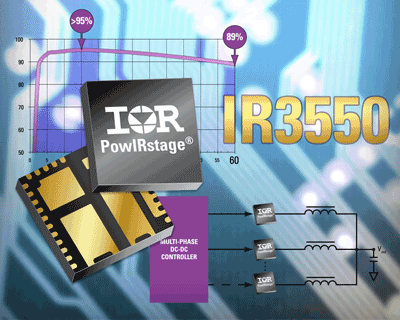International Rectifier’s IR3550 — a big feat in a small footprint
The IR3550 PowIRstage is a pioneering device that features a synchronous buck gate driver, an integrated synchronous MOSFET, and a Schottky diode all in a 6 x 6 x 0.9-mm PQFN package. The device targets high-current multiphase buck regulators and simplifies dc/dc converter design. It will find application in next-generation servers, storage, and communication systems. The company set the standards for this device high, requiring that the packaging optimized efficiency by reducing parasitic and increasing thermal conduction. The driver design of this new device had to ensure that the drive characteristics optimized the efficiency of the Generation 12.5 MOSFETs used in the device. The IR3550 design team was required to hit the efficiency targets that customers demanded and to hit the space/density requirements as well — a big feat in a small footprint. Three teams from within IR combined to accomplish this design: multiphase design, packaging, and application engineering.

The company saw that next-generation high-performance server, storage, and communication system CPUs, GPUs, and DDR memories have increasingly challenging power management requirements of up to 300-A load currents at very low voltages of around 1 V. The very high efficiency, low power losses, excellent thermals, and reduced space were some of the key demands for these next-generation systems. In order to meet these requirements, a multiphase synchronous buck converter is needed. The maximum current per phase has traditionally been limited to 15 to 30 A due to the limitations of conventional MOSFET, driver, and packaging technologies. The IR3550 PowIRstage delivers the highest benchmarked efficiency in the marketplace for high-current multiphase solutions and it does it at 60 A. This allows customers to increase the main CPU dc/dc solution efficiency significantly, saving energy and cost or meet a similar efficiency to previous generations, but without a heat sink, saving space and cost or meet a similar efficiency to previous generations, but with at least one, possibly two fewer phases For example, you can convert a six-phase design to a five- or even four-phase design. For increasing load requirements extra phases are required to handle the power, which in most cases is extremely undesirable and leads to extra board space, increased system costs and higher component count.
Paul O’Shea
Advertisement
Learn more about International Rectifier





